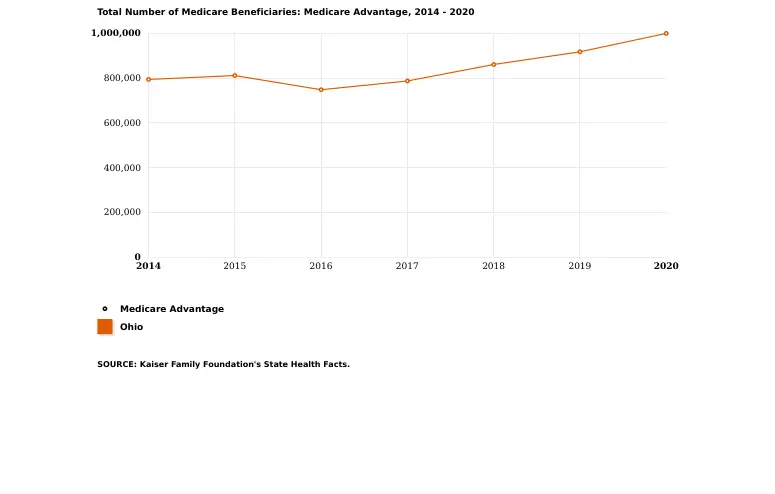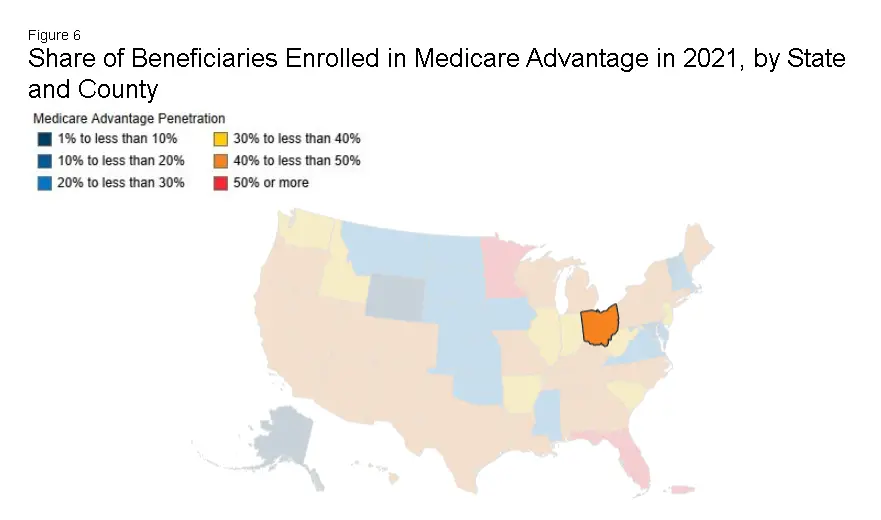PolicyScout’s Guide to Medicare Advantage Plans in Ohio
Find out which Medicare Advantage plans are available in Ohio and how you can apply.
Our content follows strict guidelines for editorial accuracy and integrity. Learn about our and how we make money.
In 2021, the Centers for Medicare and Medicaid Services (CMS) estimated that over 27 million people are now members of a Medicare Advantage scheme.
These private health care plans can help lower medical expenses and offer great additional health care benefits. But, with the hundreds of health insurance companies in the market, choosing a plan can be stressful.
This article will explore private health coverage, the different Medicare insurance options in Ohio, and how to find the best Medicare Advantage plans in the state.
What Is Medicare?
The federal Medicare program is a health scheme for individuals over the age of 65, people with disabilities, and those that suffer from ESRD (End-Stage Renal Disease) or ALS (Lou Gehrig’s disease).
The Medicare Parts Explained
Medicare has different “parts” that separate coverage and costs for medical services, tests and items.
Medicare Part A covers inpatient care, hospital expenses, or treatment in a skilled nursing facility.
Medicare Part B insurance pays for outpatient or general medical expenses, preventative services, and some other outpatient medical costs such as durable medical equipment.
Medicare Advantage (previously known as Medicare Part C) is health coverage offered by private health insurance companies. These plans provide the same benefits as Original Medicare (Part A and B cover) and additional insurance for dental, hearing, and vision expenses. Some plans also offer coverage for prescription drugs.
Medicare Part D insurance covers the costs of self-administered prescription drugs. For example, medication for blood pressure, back pain, or chronic conditions.
Your Medicare Coverage Options in Ohio
There are different coverage options when you join the federal Medicare program. Most beneficiaries have Original Medicare, Medicare Advantage, a Part D plan, or Medicare Supplement Insurance.
Here are the different Medicare plans you can get in Ohio:Original Medicare is government-run medical insurance that assists with Medicare Part A and Part B medical costs. When you sign up for Medicare, you’ll automatically join Original Medicare.
Medicare Supplement Insurance Plans provide coverage for out-of-pocket costs such as deductibles, coinsurance, and copayments.
Part D Medicare Plans, also known as Prescription Drug Plans (PDPs), are stand-alone insurance plans that help pay for the costs of prescription medication.
Terms you should know:
Monthly Premiums are fees that members of Part D drug plans, Medicare Advantage, or Medicare Supplement Plans.
Deductibles are amounts that people have to cover before their Medicare plan or insurance starts to pay for medical expenses.
Coinsurance amounts are a part of the costs that beneficiaries must pay for medical treatments, services, and tests.
Copayments are set amounts or rates that beneficiaries pay for medical services, tests, and items.
Out-of-pocket costs are any expenses that Original Medicare or a private health insurance company won’t cover.
Medicare Advantage (previously known as Medicare Part C) is private health insurance with the same benefits as Original Medicare. Most Medicare Advantage plans also offer dental and vision coverage and prescription drug plans.
There are two main kinds of Medicare Advantage plans in Ohio:
MA Plans (without Medicare prescription drug coverage) are health insurance plans that only cover Part A and Part B expenses but do not offer prescription drug coverage (Part D).
MA-PD Plans (with Medicare prescription drug coverage) are private health plans that cover Part A and B medical expenses and coverage for prescription medication (Part D).
Understanding the different MA and MA-PD plan structures
Medicare Advantage plans are also structured differently, which can affect costs, benefits, and coverage. Here are some of the different structures for private health plans:
Health Maintenance Organization Plans (HMO plans) provide health insurance through a defined network of health care providers. HMO members are only covered for in-network services and are often allocated a primary care physician.
HMO point-of-service Plans (HMO-POS plans) cover some out-of-network healthcare costs, but monthly premiums and copayments are typically higher than HMO plans.
Preferred Provider Organization Plans (PPO plans) allow you to see any health coverage provider that accepts Medicare, and you do not need a referral from your primary care doctor to see a specialist.
Private Fee-for-Service Plans (PFFS plan) allows members to see any health care provider enrolled in Medicare who accepts you.
Special Needs Plans (SNPs) are intended for individuals who have specific needs or conditions. For example, people living with chronic diseases or terminal conditions, or who live in assisted living facilities.
Private Medicare Coverage in Ohio
In Ohio, Medicare Advantage plans are becoming more popular every year. This can be seen in the state penetration rate, which is the number of Medicare Advantage members compared with all Medicare enrollees.
For example, if ten people are eligible for Medicare and eight have a Medicare Advantage plan, the penetration rate is 80% (8 out of 10 people).
MA and MA-PD plans in Ohio had a 45.2% penetration rate in 2021, which means that for every 100 Medicare-eligible people around 45 have a MA or MA-PD plan.
This graph shows how Medicare Advantage membership has grown in Ohio.
Total Number of Medicare Advantage Beneficiaries in Ohio, 2014 - 2020
According to the Kaiser Family Foundation, the number of Medicare Advantage plan members in Ohio has increased from 794,226 to 999,994 between 2014 and 2020.
Similarly, there are a large number of Medicare Advantage plan options offered by health care companies:
In 2021, there were 202 MA and MA-PD plans on offer in Ohio and in 2022, the same number of plans will be available.
If you live in Ohio and want to find MA and MA-PD plans in your county, enter your ZIP code below. You can also reach out to PolicyScout’s licensed insurance agents on 1-888-912-2132 to get your questions about Ohio Medicare Advantage plans answered.
Key Facts about Medicare Advantage in Ohio
Learning about Medicare in your state can help you understand what you can expect when you join a private health plan.
Here are some key takeaways about Medicare in Ohio:
According to the Centers for Medicare and Medicaid Services (CMS), as of November 2021 there are 2,412,500 Medicare beneficiaries in Ohio. Approximately 1,109,810 are members of an MA or MA-PD plan.
Premiums for private health plans are going down. In 2021, the average monthly premium cost for Medicare Advantage plans in Ohio was $20.18. In 2022, the average monthly premium will be $18.75.

All Medicare-eligible people in Ohio can join a MA or MA-PD plan and purchase a $0 premium Medicare Advantage plan. These are plans that do not charge members a monthly price to join.
- Just remember you will still need to pay your Medicare Part A and Part B monthly premiums when you join a $0 monthly premium plan.
Medicare is widely accepted in Ohio and you should be able to find health care providers that will treat you at Medicare rates. The majority of medical professionals in Ohio accept Medicare. Of the 39,993 registered physicians in the state, only 142 opted out of Medicare (that's under 0.004% of physicians).
Which Health Insurance Companies Offer Medicare Advantage in Ohio?
Ohio will have 202 MA and MA-PD plans in 2022. Ohio Medicare beneficiaries can purchase Medicare plans from a variety of companies, including:
Aetna Medicare
Allwell
Anthem Blue Cross and Blue Shield
Bright Health
CareSource
Cigna
Devoted Health
Health Alliance Medicare
Humana
Lasso Healthcare
Medical Mutual of Ohio
MediGold
Paramount Elite Medicare Plans
PrimeTime Health Plan
SummaCare Medicare Advantage Plans
The Health Plan
UnitedHealthcare
UPMC for Life
Wellcare
Wellcare by Allwell
Terms you should know:
Monthly Premium is the monthly fee you pay to be a member of a private Medicare plan.
Deductibles are amounts that beneficiaries have to pay before their Medicare insurance starts.
Coinsurance is the portion of medical costs that beneficiaries have to pay for medical treatment, services, and tests.
Copayments are set amounts that people have to pay for services, tests, and items.
Out-of-pocket costs are medical expenses that aren’t covered by Medicare or private insurance companies.
How to Choose Medicare Advantage Plans in Ohio
If you want to get a Medicare Advantage plan in Ohio, use these tips to find the best coverage:
1. Choose whether you want a plan that includes prescription drug coverage (MA-PD) or one that only covers Part A and B costs (MA-only).
2. Check whether the health insurance provider offers plans in your area. Many people don't know that MA and MA-PD plans vary depending on where you live.
For example, in Hamilton County, Ohio there were 62 Medicare Advantage plans to choose from in 2021. However, in Noble County, Ohio there were only 28 MA and MA-PD plans.
3. Consider the costs involved with the plan you want to sign up for and decide whether you can afford it if the price rises due to inflation.
4. Check to see if you can afford the policy's premiums and out-of-pocket expenses (costs that your plan does not cover), such as deductibles, coinsurance, and copayments.
5. You should also check the Medicare Star Rating of the plan and the health insurance firm. Read what other third-party reviewers, such as ConsumerAffairs and JD Power, have to say about the specific health insurance company and plans you're considering.
What Are Medicare Star Ratings?
The Centers for Medicare & Medicaid Services releases an annual report on the quality and performance of each private Medicare plan and provider. They do this through a scoring system called the Medicare Star Ratings.
Each plan and provider will receive a score of out five, which tells beneficiaries how well the plan performed in the year.
Here’s what the different star ratings mean:
⭐: Poor
⭐⭐: Below average
⭐⭐⭐: Average
⭐⭐⭐⭐: Good
⭐⭐⭐⭐⭐: Excellent
If you want to learn more, read our guide to Medicare Star Ratings. You can check out your plan’s current star rating by visiting the Medicare.gov website. Simply search your county’s ZIP code, find your plan, and check the number of stars it received.
6. Ask with friends and family who have Medicare about their experiences with specific private insurance providers or Medicare Advantage plans.
7. Discuss the benefits, perks, and coverage of your medicare contract with a licensed health insurance agency to see if the plan is the right one for you.
8. Compare your options before making a final purchase and see if there are other providers in your area that offer similar plans.

(Source: Pexels)
Important Enrollment Dates for Medicare in Ohio
The next step after you’ve found a plan is to apply. Here are some important enrollment dates you should keep in mind if you want to join a Medicare Advantage plan in Ohio:
Initial Enrollment Period
This is your first opportunity to enroll in Medicare when you become eligible and it begins three months before your 65th birthday. During the Initial Enrollment Period, you can enroll in Medicare Parts A and B, Medicare Advantage, or a Prescription Drug Plan.
General Enrollment Period
If you missed your Initial Enrollment Period you can sign up for Medicare Parts A and B, as well as a Medicare Advantage Plan, from January 1st to March 31st during the General Enrollment Period.
Special Enrollment Period
These are the periods when you can enroll outside of the standard enrollment dates. There are specific circumstances when someone qualifies for a Special Enrollment Period. For example, if you relocate to another state or if your union healthcare coverage expires.
For more information, feel free to read our guide to Medicare Open Enrollment Period 2022.
How Can I Find Out More about My Health Care Options?
PolicyScout's Medicare Hub covers a range of topics, including Original Medicare, Medicare plans, Medicare Supplement Insurance. You'll also be able to find information on prices, enrollment, coverage, and Medicare benefits.
If you need help with your insurance coverage, our team can provide expert guidance and assistance with all Medicare-related issues. Reach out on 1-888-912-2132 or send an email to Help@PolicyScout.com to speak with one of our Medicare consultants.